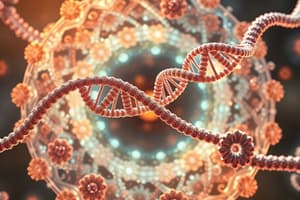Podcast
Questions and Answers
What is the main function of the Golgi body?
What is the main function of the Golgi body?
- Oxidative phosphorylation
- Generation of adenosine triphosphate
- Transporting secretions from the cell (correct)
- Protein synthesis
Which organelle contains enzymes for digestion of macromolecules?
Which organelle contains enzymes for digestion of macromolecules?
- Mitochondria
- Ribosomes
- Lysosomes (correct)
- Plastids
Where do light reactions take place in a plant cell?
Where do light reactions take place in a plant cell?
- Golgi body
- Ribosomes
- Mitochondria
- Chloroplasts' grana (correct)
Which organelle is responsible for trapping light energy in plant cells?
Which organelle is responsible for trapping light energy in plant cells?
What is the function of mitochondria in a cell?
What is the function of mitochondria in a cell?
Which organelle is composed of flattened sacs?
Which organelle is composed of flattened sacs?
Where does protein synthesis primarily occur in a cell?
Where does protein synthesis primarily occur in a cell?
True or False: The nucleus is bound by a single membrane structure.
True or False: The nucleus is bound by a single membrane structure.
What pigment-containing organelles are found only in plant cells?
What pigment-containing organelles are found only in plant cells?
What organelle is responsible for digestion of macromolecules?
What organelle is responsible for digestion of macromolecules?
Flashcards are hidden until you start studying
Study Notes
Bacterial Structures
- Bacterial flagellum consists of three parts: filament, hook, and basal body.
- Filament is the longest part, extending from the cell surface outward.
- Pili and fimbriae are surface structures, but do not aid in motility; pili are tubular proteins, while fimbriae are bristle-like fibers.
- Fimbriae help bacteria attach to surfaces such as rocks and host tissues.
Ribosomes and Inclusion Bodies
- Ribosomes in prokaryotes associate with the plasma membrane, measuring approximately 15 nm by 20 nm.
- Made up of two subunits: 50S and 30S, forming 70S prokaryotic ribosomes.
- Ribosomes serve as sites for protein synthesis; multiple ribosomes can translate a single mRNA, forming polyribosomes or polysomes.
- Inclusion bodies store reserve materials in prokaryotic cytoplasm, not membrane-bound; examples include phosphate, cyanophycean, and glycogen granules.
- Gas vacuoles occur in photosynthetic bacteria, enabling buoyancy.
Eukaryotic Cells
- Eukaryotes comprise protists, plants, animals, and fungi.
- Plasma membrane's quasi-fluid nature allows lateral protein movement, essential for cell functions like growth and division.
- Plasma membrane is selectively permeable, enabling passive transport of some molecules across it, like simple diffusion and osmosis for water.
- Active transport, requiring ATP, moves molecules against their concentration gradient, such as Na+/K+ Pump.
Cell Wall
- Non-living, rigid structure surrounding the plasma membrane in fungi and plants, providing shape and protection against damage and pathogens.
- Algal cell walls are composed of cellulose, galactans, mannans, and minerals; plant cell walls are made of cellulose, hemicellulose, pectins, and proteins.
- Primary cell wall in young plant cells is capable of growth; secondary wall forms later on the inner side.
- Middle lamella, made of calcium pectate, glues neighboring cells together, with plasmodesmata connecting their cytoplasm.
Endomembrane System
- Membranous organelles like the endoplasmic reticulum (ER), Golgi complex, lysosomes, and vacuoles form a coordinated endomembrane system, each with distinct structures and functions.
Centrosome and Centrioles
- Centrosome contains two centrioles, which are cylindrical structures arranged perpendicularly and made of tubulin protein in triplets.
- Centrioles form the basal bodies for cilia or flagella and contribute to spindle fiber formation during animal cell division.
Nucleus
- First described by Robert Brown in 1831; chromatin is the term for the nucleus's stained material, defined by Flemming.
- Interphase nucleus has extended chromatin fibers, a nuclear matrix, and nucleoli, which are spherical bodies involved in ribosomal RNA synthesis.
Studying That Suits You
Use AI to generate personalized quizzes and flashcards to suit your learning preferences.




